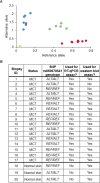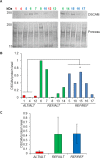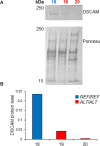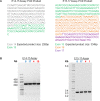A synonymous germline variant in a gene encoding a cell adhesion molecule is associated with cutaneous mast cell tumour development in Labrador and Golden Retrievers
- PMID: 30901340
- PMCID: PMC6447235
- DOI: 10.1371/journal.pgen.1007967
A synonymous germline variant in a gene encoding a cell adhesion molecule is associated with cutaneous mast cell tumour development in Labrador and Golden Retrievers
Abstract
Mast cell tumours are the most common type of skin cancer in dogs, representing a significant concern in canine health. The molecular pathogenesis is largely unknown, but breed-predisposition for mast cell tumour development suggests the involvement of inherited genetic risk factors in some breeds. In this study, we aimed to identify germline risk factors associated with the development of mast cell tumours in Labrador Retrievers, a breed with an elevated risk of mast cell tumour development. Using a methodological approach that combined a genome-wide association study, targeted next generation sequencing, and TaqMan genotyping, we identified a synonymous variant in the DSCAM gene on canine chromosome 31 that is associated with mast cell tumours in Labrador Retrievers. DSCAM encodes a cell-adhesion molecule. We showed that the variant has no effect on the DSCAM mRNA level but is associated with a significant reduction in the level of the DSCAM protein, suggesting that the variant affects the dynamics of DSCAM mRNA translation. Furthermore, we showed that the variant is also associated with mast cell tumours in Golden Retrievers, a breed that is closely related to Labrador Retrievers and that also has a predilection for mast cell tumour development. The variant is common in both Labradors and Golden Retrievers and consequently is likely to be a significant genetic contributor to the increased susceptibility of both breeds to develop mast cell tumours. The results presented here not only represent an important contribution to the understanding of mast cell tumour development in dogs, as they highlight the role of cell adhesion in mast cell tumour tumourigenesis, but they also emphasise the potential importance of the effects of synonymous variants in complex diseases such as cancer.
Conflict of interest statement
The authors have declared that no competing interests exist.
Figures






References
-
- Dobson JM, Samuel S, Milstein H, Rogers K, Wood JL. Canine neoplasia in the UK: estimates of incidence rates from a population of insured dogs. J Small Anim Pract. 2002;43(6):240–6. . - PubMed
Publication types
MeSH terms
Substances
Associated data
LinkOut - more resources
Full Text Sources
Other Literature Sources

